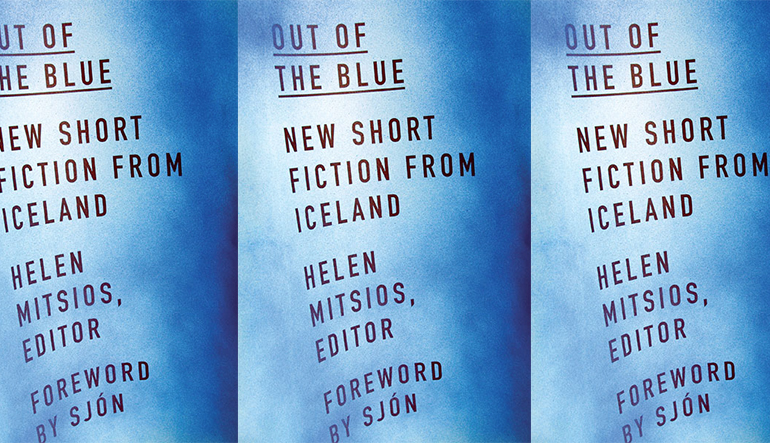Review: OUT OF THE BLUE: NEW SHORT FICTION FROM ICELAND Edited by Helen Mitsios

Out of the Blue: New Short Fiction from Iceland
Edited by Helen Mitsios
University of Minnesota Press, April 2017
216 pp; $24.95
Reviewed by Daryl Farmer
Iceland has a rich literary tradition that includes the Icelandic Sagas and Nobel Prize winner Halldór Laxness. Today, the small island country reads and writes more books per capita than any other nation.
So the quality of the recent anthology Out of the Blue: New Short Fiction from Iceland is no surprise. What is surprising is the wide range within: stories that move from realism to surrealism to the fabular to magical realism, and from humorous to heartbreaking to bizarre. The anthology consists of work by twenty of Iceland’s most well known authors. While the Icelandic voice and character are revealed throughout, the stories stray far from tourist brochure representations; they are not filled with glacial lagoons, ice caves, thermal pools, or Björk.
In fact, the reader is five stories into the anthology before first finding a story actually set in Iceland. No matter. An Icelander on vacation is every bit as revealing about the country as one at home. Case in point is the opening story, “Self Portrait” by Auður Jónsdóttir, which tells of an Icelandic family on vacation in Sardinia. When the mother, Frida, finds herself and her toddler son, separated from her controlling husband, she courts danger by going on a walking journey with seven men she meets along the way.
Perhaps the strongest story is “One Hundred Fifty Square Meters,” by Kristín Eiríksdóttir. Here, young couple Aesa and Dani are forced to move out of their current apartment. When they find a new one for a surprisingly low rent, they feel compelled to take it, despite the bizarre conditions: the previous occupant has disappeared, and it is unclear whether or not he might return. The landlord insists the man’s possessions, including a collection of books and artifacts related to the Cold War, stay in the apartment. The surreal effect of this story is subtle, but Dani’s transformation is haunting and plays on the idea that, at least in part, we are defined by our surroundings.
Other characters throughout these stories include a down and out artist who finds success through his benefactor and lover; a man trying to come to grips with his daughter’s rare disease; a couple reunited after thirty years of separation; a husband who stays behind and writes his wife’s travel journey from home. The collection ends with a fabular tale about the CEO of a major company who sacrifices his wealth to read and study the stars. It is a final transformation in a book full of them.
The stories in this collection are often sad, funny, heartbreaking. At times they are ghostly, but not horrific. If there is a common thread it is in the stories’ subtle yet ethereal effect. Many of the stories flirt with the edges of magical realism without ever losing their realistic grounding. Often, this creates a haunting effect and allows us to see between the lines of these human lives.
This collection is a wonderful way into deepening one’s understanding of this cerebral and magical place.
Daryl Farmer is the author of the nonfiction book Bicycling beyond the Divide and Where We Land, a collection of short stories. His recent work has appeared in The Whitefish Review, Hayden’s Ferry Review, and Gingerbread House. He is an associate professor at the University of Alaska-Fairbanks where he teaches creative writing and literature.


